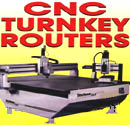| CNC
Router Helps Reduce Time to Produce Automated Wet Process Machines From 4800 to 1500 Hours By Bill Loomis
President
Poly Design, Inc.
Garland, Texas
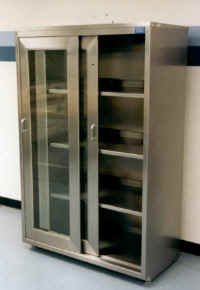 Switching from conventional
power tools to a computerized numerical control (CNC) router helped reduce the time to
produce automated wet process machines from 1900 to 1000 hours. Poly Design was able to
reduce its price for a three-position automatic transfer machine that cleans cassette
boats filled with CD-ROMs or semiconductor wafers by 25% to $275,000 while increasing its
profit margin. For example, in the past it took five days to cut the parts for the eight
cassette boats used this machine and two days for assembly. The CNC router automatically
cuts the parts in only four hours and its accuracy is so much higher than power tools that
assembly time is reduced from two days to one day. The time savings for producing one
machine (1900-1000=900 hrs.) more than pays for the router at any reasonable hourly labor
rate. Switching from conventional
power tools to a computerized numerical control (CNC) router helped reduce the time to
produce automated wet process machines from 1900 to 1000 hours. Poly Design was able to
reduce its price for a three-position automatic transfer machine that cleans cassette
boats filled with CD-ROMs or semiconductor wafers by 25% to $275,000 while increasing its
profit margin. For example, in the past it took five days to cut the parts for the eight
cassette boats used this machine and two days for assembly. The CNC router automatically
cuts the parts in only four hours and its accuracy is so much higher than power tools that
assembly time is reduced from two days to one day. The time savings for producing one
machine (1900-1000=900 hrs.) more than pays for the router at any reasonable hourly labor
rate.
Poly Design produces a wide
range of clean room equipment including wet process stations, equipment for process
stations, stainless steel fixtures, quartz cleaning stations, desiccators and storage
cabinets, chemical transporting carts and benches and work tables. Each unit produced by
the firm is designed to solve a specific application problem and no two units are exactly
alike. While some applications require the design of an entirely new assembly, most need
only a minor modification to one of the company’s broad line of existing products.
Automated transfer machines
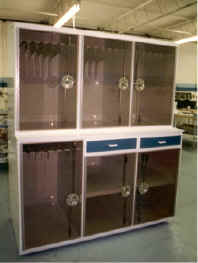 One
of the firm’s more popular products is automated transfer stations designed for
cleaning cassette boats. These machines replace a slow and difficult manual process in
which components are loaded into boats and then dipped into a series of several tanks
filled with cleaning fluids. The boats, which weigh about 16-pounds when fully loaded,
must be held submerged in three different tanks and shaken for about 10 minutes in each
order to thoroughly clean one load. One operator is able to process about 200 parts every
hour using this approach and the job has a potential risk of repetitive stress injury. One
of the firm’s more popular products is automated transfer stations designed for
cleaning cassette boats. These machines replace a slow and difficult manual process in
which components are loaded into boats and then dipped into a series of several tanks
filled with cleaning fluids. The boats, which weigh about 16-pounds when fully loaded,
must be held submerged in three different tanks and shaken for about 10 minutes in each
order to thoroughly clean one load. One operator is able to process about 200 parts every
hour using this approach and the job has a potential risk of repetitive stress injury.
Poly Design has automated
this cleaning process with a transfer machine that provides superior cleaning and a cycle
time of only 4 minutes. This machine processes 1500 units per hour and the danger of
injury is eliminated by the fact that rather than continuously dipping and shaking the
boats, the operator only needs to load a boat onto the machine every 4 minutes. The
machine also includes a wet loading area that holds four runs at a time, a filtered and
recirculating heated acid bath, two quick dump rinsers, a stainless steel ultrasonic
cleaning tank and a wet unload area that also holds four runs.
Plastic machining
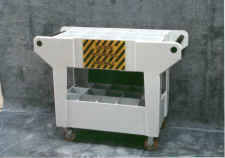 Each
station is 4.5 feet wide, 12 feet long and 7 feet high. The majority of the machine,
including the cabinets for each station, the shell tanks and the baskets, is machined from
polypropylene, although the boats are made of polyvinylidene fluoride (PVDF). These types
of plastics are used because they are corrosion-resistant and do not emit particles that
might contaminate electronic components. In the past, the panels and other components used
to build the cabinets and tanks were machined using table saws, routers and hand saws.
This was a time-consuming manual process. It took one person about 40 hours to cut out and
prepare the parts for the eight baskets used for one machine, for example. Cutting out all
of the components needed for one machine took about 900 hours. Each
station is 4.5 feet wide, 12 feet long and 7 feet high. The majority of the machine,
including the cabinets for each station, the shell tanks and the baskets, is machined from
polypropylene, although the boats are made of polyvinylidene fluoride (PVDF). These types
of plastics are used because they are corrosion-resistant and do not emit particles that
might contaminate electronic components. In the past, the panels and other components used
to build the cabinets and tanks were machined using table saws, routers and hand saws.
This was a time-consuming manual process. It took one person about 40 hours to cut out and
prepare the parts for the eight baskets used for one machine, for example. Cutting out all
of the components needed for one machine took about 900 hours.
The polypropylene components
are assembled using a Laramie welding gun that directs heated air onto the joint. First,
the joints are tacked together with the welding gun, then triangular polypropylene welding
rod is melted into the joint to create the final weld. The relatively poor accuracy of the
power tools used in the past meant that a considerable amount of touchup work and hand
fitting was required during the assembly process. As a result, it took three to five
people about 900 hours or a total of about 3600 hours to assemble and test the machine.
Innovative router
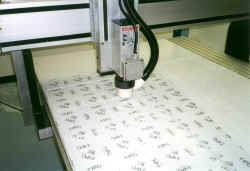 In
an effort to reduce the amount of labor required to produce these machines, Poly Design
managers evaluated a number of different CNC machine tools. First, they considered
conventional machining centers but they discovered that the cost of a machine large enough
to handle the 4 foot by 8 foot sheets used to produce the components would have been
around $200,000. Next, the company looked at a new breed of gantry routers that interface
with CAD systems, have a large cutting area, and a relative low price. These machines are
not capable of handling heavy cuts in ferrous metals, however, they can handle heavy cuts
in plastic and wood and light cuts in metal which made them ideally suited for Poly Design’s
workload. In
an effort to reduce the amount of labor required to produce these machines, Poly Design
managers evaluated a number of different CNC machine tools. First, they considered
conventional machining centers but they discovered that the cost of a machine large enough
to handle the 4 foot by 8 foot sheets used to produce the components would have been
around $200,000. Next, the company looked at a new breed of gantry routers that interface
with CAD systems, have a large cutting area, and a relative low price. These machines are
not capable of handling heavy cuts in ferrous metals, however, they can handle heavy cuts
in plastic and wood and light cuts in metal which made them ideally suited for Poly Design’s
workload.
Poly Design managers looked
at several machines of this type and ended up purchasing the Techno Series III from
Techno-Isel, New Hyde Park, New York. The selected this machine because it offers an
unusually good mix of accuracy, size and price. The machine's 0.0002 inch resolution and
repeatability and 0.003 inch/foot absolute accuracy ensure that plastic components are
faithful representations of the designs created on the computer. The machine’s
working area of 59 inches by 102 inches with a Z-axis height of 8 inches is large enough
to handle everything that Poly Design makes. The price is less than $42,000 and includes
CNC software used to program the machine.
Computerized machining
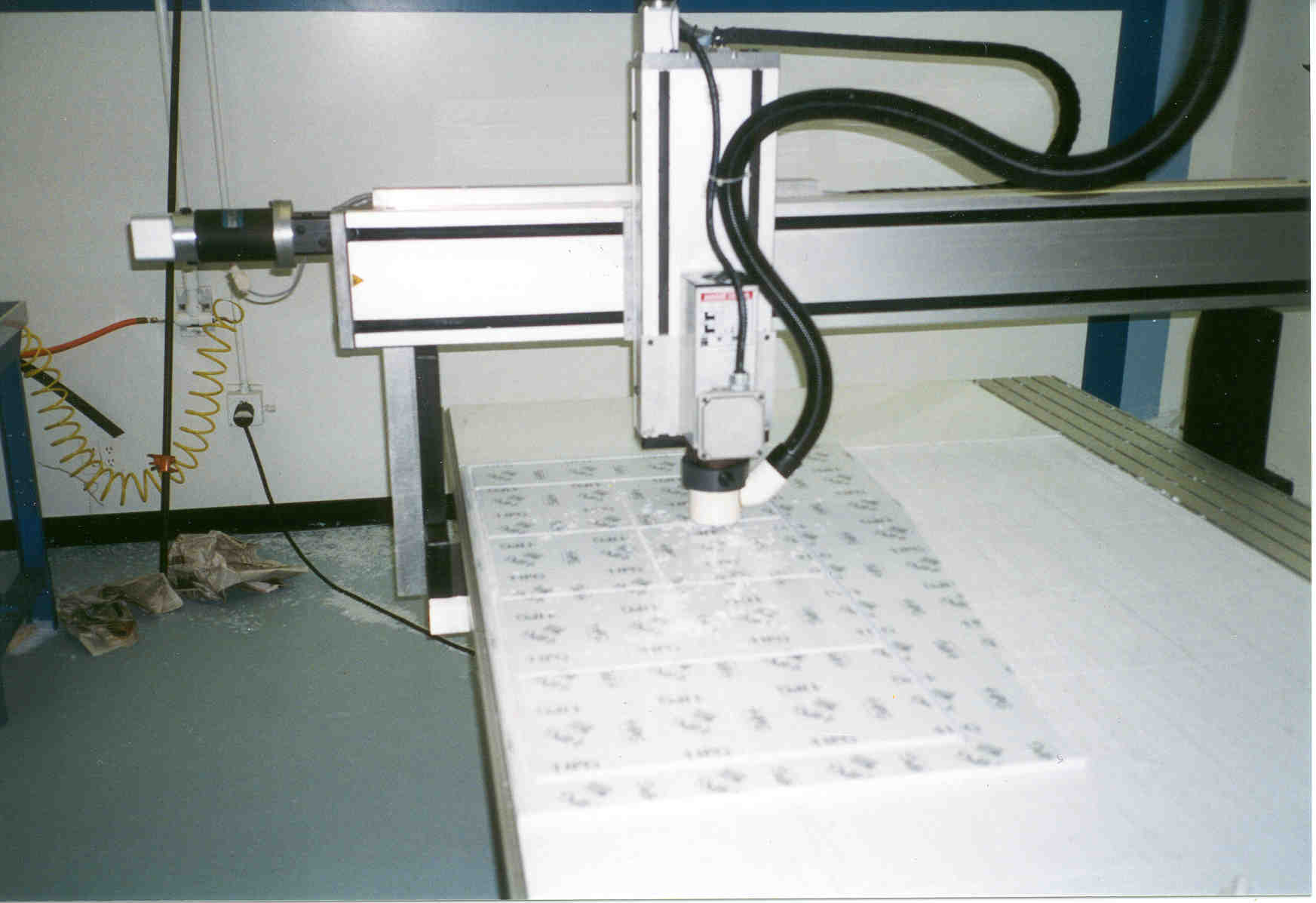 Now, the firm’s
engineers begin the design process by using the FastCAD or AutoCAD Lite software to sketch
out their design on the computer. By manipulating their model on the screen, panning,
zooming and rotating, they are able to validate all critical dimensional relationships
before they even begin to cut plastic. To provide a final validation step, they put a
marker in the machine spindle and used it to trace the outline of the program on
posterboard. Once the components for a machine are designed, they are nested together onto
a 4 foot by 8 foot pattern to minimize waste. This optimization of the nesting process has
saved a considerable amount of material relative to hand nesting. Now, the firm’s
engineers begin the design process by using the FastCAD or AutoCAD Lite software to sketch
out their design on the computer. By manipulating their model on the screen, panning,
zooming and rotating, they are able to validate all critical dimensional relationships
before they even begin to cut plastic. To provide a final validation step, they put a
marker in the machine spindle and used it to trace the outline of the program on
posterboard. Once the components for a machine are designed, they are nested together onto
a 4 foot by 8 foot pattern to minimize waste. This optimization of the nesting process has
saved a considerable amount of material relative to hand nesting.
The
Techno router cuts out the parts considerably faster than the previous manual process. It
takes only 4 hours, for example, to cut out the parts for all 8 baskets for one transfer
machine. All of the components needed for a machine can be produced in only 100 hours of
cutting, a reduction of about 89% compared to power tools. Further savings have been
achieved because the machine does not even require the continuous presence of an operator.
The operator typically performs some other operation nearby. When the machine completes
all the components nested on one sheet, the operator loads a new program and a new sheet
and restarts the router.
Greater
accuracy
The Techno machine's
accuracy is the result of several features inherent to the table, such as the use of ball
screws and servo motors. For example, anti-backlash ball screws permit play-free motion
that makes it possible to produce accurate circles and inlays. The ballscrews have
excellent power transmission due to the rolling ball contact between the nut and screw.
This rolling contact also ensures longer life and greater rigidity during the life of the
system because of the reduced wear as compared to ACME screws and nuts, which have a
sliding friction contact.
Faster assembly
The much higher level of
accuracy achieved by the router saves a considerable period of time during the assembly
process. Everything fits together perfectly, so the need for manual finishing and fitting
has been eliminated. As a result, two people can assembly and test a machine in only 700
hours. The total assembly time is only 1400 hours, a 61% reduction. Besides these time
savings, the quality of the finished machine has been improved. Customers notice that
everything fits together better and opens and closes more smoothly. Servicing the machines
built with the router has also become much simpler since the components are now all
interchangeable.
As
a result, Poly Design has been able to reduce the cost of their wet process machines by
25% while actually increasing the firm’s profit margin. While the firm originally
targeted these machines at producers of CD-ROMs, their high quality and low price has made
it possible for the firm to enter the market for cleaning semiconductor wafers. The Techno
machine has provided outstanding service, requiring nothing other than minimal preventive
maintenance in six months of near continuous operation. The dramatic improvements in
cutting and assembly provided by this machine contrasted with its low price means that it
easily pays for itself every month.
1) Stainless steel storage cabinet produced by
Poly Design.
2) Poly Pro storage cabinet produced by Poly Design.
3) Acid bottle cart produced by Poly Design.
4-5) The Techno-Isel router used by Poly
Design. |

